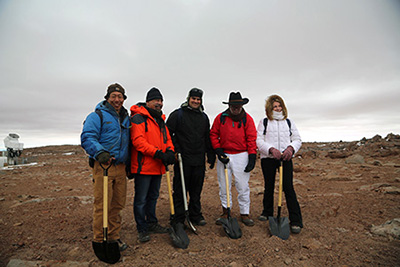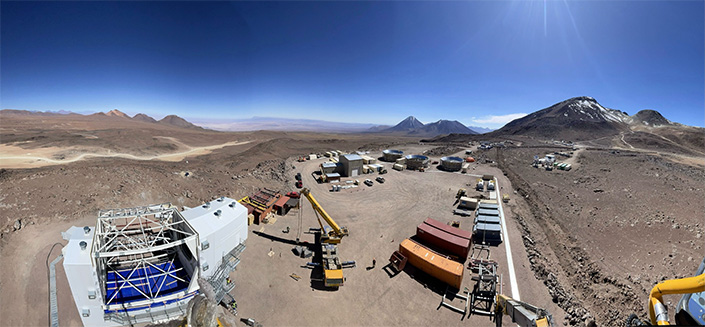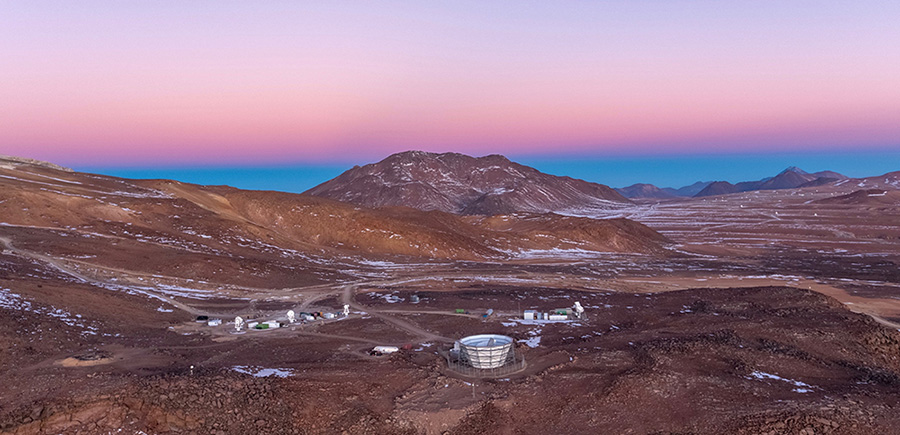$30 Million in Funding Helps Scientists Study Universe’s Oldest Light
Latest grant from the Simons Foundation will complete groundbreaking observatory
Story by:
Published Date
Article Content
Everyone has an origin story, including the universe. The Big Bang Theory is the leading explanation for the universe’s origin — one that began 13.8 billion years ago from an incomprehensibly dense, hot pinprick that underwent an expansion so rapid that “violent” doesn’t begin to capture it.
About 400,000 years after the Big Bang, the cosmos cooled enough for photons to travel freely, creating the oldest light in the universe, known as the cosmic microwave background (CMB). The CMB is the remnant radiation from the Big Bang that has expanded with the universe and now appears in the microwave portion of the electromagnetic spectrum. It carries an imprint of cosmic history, potentially revealing what happened a trillionth of a trillionth of a trillionth of a second after the Big Bang.

What happened in those moments after the Big Bang is a question cosmologists hope to answer with the Simons Observatory. The Simons Foundation has provided $28.8 million and the Heising-Simons Foundation has provided $1.5 million to the University of California San Diego to complete the last phase of construction on the observatory. Construction began in 2019, and the anticipated completion date of April 2024 coincides with the 86th birthday of Simons Foundation co-founder Jim Simons.
"The additional $28.8 million provided by the Simons Foundation for the completion of Simons Observatory's construction is testimony to the outstanding work done by the team, and to the expectation of breakthrough discoveries by the Observatory in years to come," said Senior Vice President for Physics at the Simons Foundation Greg Gabadadze.
“The Simons Observatory holds the transformative power to discover secrets hidden in the cosmic tapestry, revealing the mysteries of the universe with unparalleled precision,” said UC San Diego Chancellor Pradeep K. Khosla. “We are profoundly grateful for Jim and Marilyn Simons’ vision and generous support for our search to answer fundamental questions about the scientific origins of the universe and expand the global impact of our $1.64-billion research enterprise.”

The observatory began as a collaboration between the Simons Foundation, member institutions, and six founding scientists — Brian Keating and Kam Arnold (UC San Diego), Mark Devlin (University of Pennsylvania), David Spergel and Suzanne Staggs (Princeton University), Adrian Lee (University of California Berkeley) and Jeff McMahon (University of Chicago). Since the groundbreaking in 2019, it has grown to include partner institutions and collaborators around the world.
“We have an amazing team of partner institutions and scientists,” said Brian Keating, UC San Diego professor of physics and principal investigator. “The founding scientists have been vital to the intellectual design, construction process and funding. Without their leadership, the concept and execution of the observatory would not have happened.”
The observatory, which will also investigate the nature of dark matter and how gravity gave structure to the universe, is located in the northern region of the Andes Mountains in Chile’s Atacama Desert. At an elevation of over 17,000 ft., it’s one of the highest, driest places on Earth, making it ideal for microwave cosmology.
Before the telescopes will be operational, the array needs to undergo several checks and measures to ensure the equipment is calibrated and everything is functioning optimally. “There are literally millions of parts that have come from around the world, and they all have to work flawlessly,” stated Keating. “We can’t say, ‘Oh, the mount doesn't work. That’s okay.’ There is zero tolerance for failure.”
Once calibrated, scientists will begin making real astronomical measurements of the unknown cosmos, although it may take several years before they collect and interpret enough data to publicly announce any discoveries about the origin and evolution of the universe.
Trying to uncover the origins of the universe is the ultimate in high-risk, high-reward research. “Jim and Marilyn have always been driven by a sense of wonder at the cosmos. They are part of the reason I’m inspired to address these questions,” said Keating. “This is a dream project for all of us.”
Co-founded in 1994 by Jim and Marilyn Simons, the Simons Foundation supports basic scientific research in the pursuit of understanding the phenomena of our world. The foundation has donated over $88 million to the construction of the observatory, in addition to more than $12 million in funding for the POLARBEAR-Simons Array, which will eventually become part of the observatory.
The Heising-Simons Foundation works with its partners to advance sustainable solutions in climate and clean energy, enable groundbreaking research in science, enhance the education of our youngest learners, and support human rights for all people. In addition to the most recent support, the Heising-Simons Foundation has given nearly $2.7 million to date for the Simons Observatory, which included nearly $1 million to UC San Diego and approximately $1.7 million to the University of California Berkeley.
 LEARN MORE ABOUT HOW YOU CAN SUPPORT UC SAN DIEGO »
LEARN MORE ABOUT HOW YOU CAN SUPPORT UC SAN DIEGO »
Share This:
You May Also Like
UC San Diego is Strengthening U.S. Semiconductor Innovation and Workforce Development
Technology & EngineeringStay in the Know
Keep up with all the latest from UC San Diego. Subscribe to the newsletter today.




